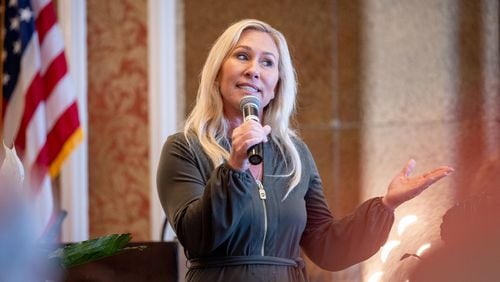Student transfers
About one-third of students will attend more than one college before they earn a bachelor’s degree, according to national studies. Several University System of Georgia colleges attract transfer students. Here is the number of students transferring into these popular colleges:
College … Transfers from USG schools … From other Georgia colleges … From out of state
Georgia Gwinnett … 827 … 373 … 377
Georgia Perimeter … 1,748 … 1,290 … 2,031
Georgia State … 2,714 … 705 … 1,036
Georgia Tech … 842 … 45 … 304
Kennesaw State … 2,121 … 824 … 1,042
University of Georgia … 2,273 … 294 … 363
Source: University System of Georgia, fall 2011 transfer report.
Leandra Moultrie's path to a college degree may seem circuitous to some, but it's becoming more common.
The 21-year-old transferred to Georgia State University this semester after starting at Georgia Perimeter College, a two-year school. Moultrie saved money by attending Georgia Perimeter, where tuition is about half that of a typical four-year college. And the school’s small classes eased her into the college experience.
Gone are the days when college students attend just one college to earn a bachelor’s degree. Instead college is becoming a land of transfer students. One-third of of all students switch schools at least once before earning a degree, according to the National Student Clearinghouse. Many of today’s transfer students said they’re driven by economics, knowing they can save thousands by taking core classes at a less expensive school.
As Georgia colleges work to improve graduation rates they’re paying special attention to transfer students. College leaders have promised students more course credits will be accepted as they move from one school to another. Some campuses created special orientation and advising programs for transfer students. And Georgia State is conducting a study to determine what skills these students need to successfully earn a bachelor’s degree.
These methods and others will be in the plans colleges will turn in to Gov. Nathan Deal this week as part of an initiative to help more Georgians earn degrees. Deal’s Complete College Georgia program says the state’s future economic success requires more people to have education beyond high school.
While colleges in Georgia and across the country have long said students no longer follow a “traditional” path of attending just one institution, it is only in the past couple of years that comprehensive data has proved this to be true. Nearly 41,000 students transferred into a University System of Georgia college in fall 2011, about a 25 percent increase over the past five years. Georgia State, Kennesaw State University and University of Georgia are some of their most popular destinations.
The rise of transfer students is particularly evident at Georgia State. Transfer students make up more than half of the school’s undergraduates and nearly 6,000 of them attended Georgia Perimeter at some point, associate provost Tim Renick said. The college has had record size transfer classes the past three semesters and expects the same for this fall.
Renick said some schools prefer freshmen over transfer students thinking the younger, less-experienced students are better prepared. He called those opinions short-sighted.
“Do you know what’s the best predictor of success in college? Already having success in college,” Renick said. “When you admit transfer students they have taken college courses and done well. It’s a better indicator than a SAT score.”
Moultrie said starting at a two-year college taught her responsibility and made her better prepared.
“I’m at Georgia State now because I want to be here, not because someone told me I’m supposed to go to college,” the accounting major said.
Some students transfer because they switched majors to a program not offered at their current college. Others didn’t have the grades to get into their desired college out of high school but hope high college marks will earn them admission as a transfer student.
Many transfer students say their initial decision to go to a two year school was a good first choice for them and not one made because they had no other options. Jordan Bertram chose Georgia Perimeter and then chose to attend Kennesaw State as an education major after fininsihing at Georgia Perimeter. Bertram said she and her friends didn’t think less of Georgia Perimeter because it was a two-year college.
“Two-year schools have a better reputation now,” Bertram said. “If anything it shows we were smarter to start somewhere with smaller classes and smaller tuition.”
Georgia State has noticed some students start with them but then transfer to Georgia Perimeter to save money because they lose a scholarship or a job and then return to the four-year college for a bachelor’s degree, Renick said.
Ingrid Santamaria is studying criminal justice this semester at Kennesaw State University after spending last year at Chattahoochee Technical College. She was unsure about college until a high school counselor suggested a technical college because of the low tuition.
“I didn’t want to waste my money but it was a good place for me to get some basics and think about what I really want to do,” the 20-year-old said. “I wasn’t ready for a four-year college when I graduated high school but I am now.”
Santamaria is one of the nearly 4,600 students who transfer from the state’s technical system to the university system each year.
Leaders from the two systems have been working to provide a seamless transition when students move from one group of schools to the others. A deal approved in March increased to 27 the number of courses the university system will automatically accept.
The agreement saves students time and money because it guarantees colleges won’t reject these classes claiming it doesn’t match what’s taught on their campuses. When that happens, students repeat courses and pay twice to learn the same material.
In another step to help transfer students, the university system is considering awarding associate degrees to students who transferred from a two-year college to a four-year, said Lynne Weisenbach, a vice chancellor.
Colleges nationwide are looking into this “reverse transfer” and the associate degree can come from either the two-year school where students started or the four-year school they wound up in.
About half the students who earn a bachelor’s degree after transferring don’t know an associate degree is an option, national studies show. Awarding these students associate degrees guarantees they have a diploma and a leg up in the job market should they drop out before completing a four-year degree, Weisenbach said.
Transfer students have varying degrees of success. Faculty at Georgia Perimeter and Georgia State work closely together to make sure students have the right foundation, Renick said. As a result, Georgia Perimeter transfer students at higher rates than transfer students who came from other colleges.
Renick said they’re not seeing the same success with other transfer students because there have not been enough discussions about what Georgia State expects and needs students to learn before they arrive.
The college is studying what besides grades and the number of credits hours could be used to determine what students have learned. For example, students may have received an “A” in a community college class because they learned the material but their writing and research skills may not be strong enough for a four-year college, Renick said.
Georgia State will spend about 18 months experimenting with different tools — such as student survey or faculty interviewing students — to better measure transfer students’ strengths and weaknesses.
“We all need these students to do well,” Renick said. “They are part of our mission at Georgia State and they are part of the state’s mission.”
About the Author





